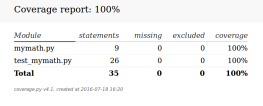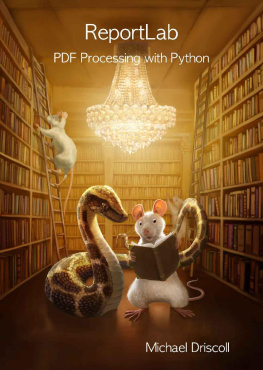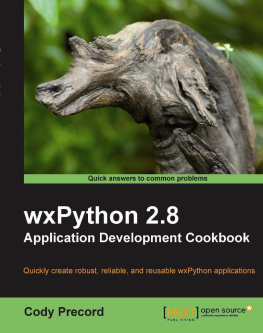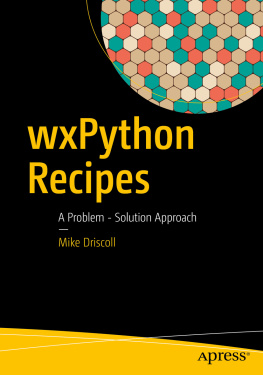Michael Driscoll - Creating GUI Applications with wxPython
Here you can read online Michael Driscoll - Creating GUI Applications with wxPython full text of the book (entire story) in english for free. Download pdf and epub, get meaning, cover and reviews about this ebook. year: 2019, publisher: leanpub.com, genre: Computer. Description of the work, (preface) as well as reviews are available. Best literature library LitArk.com created for fans of good reading and offers a wide selection of genres:
Romance novel
Science fiction
Adventure
Detective
Science
History
Home and family
Prose
Art
Politics
Computer
Non-fiction
Religion
Business
Children
Humor
Choose a favorite category and find really read worthwhile books. Enjoy immersion in the world of imagination, feel the emotions of the characters or learn something new for yourself, make an fascinating discovery.

- Book:Creating GUI Applications with wxPython
- Author:
- Publisher:leanpub.com
- Genre:
- Year:2019
- Rating:3 / 5
- Favourites:Add to favourites
- Your mark:
- 60
- 1
- 2
- 3
- 4
- 5
Creating GUI Applications with wxPython: summary, description and annotation
We offer to read an annotation, description, summary or preface (depends on what the author of the book "Creating GUI Applications with wxPython" wrote himself). If you haven't found the necessary information about the book — write in the comments, we will try to find it.
Creating GUI Applications with wxPython — read online for free the complete book (whole text) full work
Below is the text of the book, divided by pages. System saving the place of the last page read, allows you to conveniently read the book "Creating GUI Applications with wxPython" online for free, without having to search again every time where you left off. Put a bookmark, and you can go to the page where you finished reading at any time.
Font size:
Interval:
Bookmark:

This book is for sale at http://leanpub.com/creatingapplicationswithwxpython
This version was published on 2020-12-07

* * * * *
This is a Leanpub book. Leanpub empowers authors and publishers with the Lean Publishing process. Lean Publishing is the act of publishing an in-progress ebook using lightweight tools and many iterations to get reader feedback, pivot until you have the right book and build traction once you do.
* * * * *
Writing a book takes a lot of work. Finding people who are willing to review rough versions of the book is difficult and sometimes not even possible. I was fortunate while writing this book to have several amazing people who helped me out by reading early versions of the book. I want to thank Charles McKnight for his many insights into my chapters. Tony Cappellini and Steve Nicholson were quite helpful in finding text issues and asking pertinent questions. Sundeep Agarwal also had many good ideas for improvements.
I also had help from Ignace, Geert Dobbels and Oliver Schoenborn as well as several others. I cant name everyone who helped me because some of them just used handles or their emails were lost. But I am grateful for all the help I received. Every bug report, no matter how small, has helped make this book better for the next person who reads it.
Special thanks goes out to all the core developers of the wxPython GUI Toolkit. Without them, this book wouldnt even exist!
Thank you!
Mike
Welcome to Creating GUI Applications with wxPython. In this book, we will learn how to create several different desktop applications using the wxPython GUI toolkit. Each of the applications that we create will run on Windows, Mac and Linux. All of the code is open source and free for you to use and change at will. We will start off the book with aquick introduction to the wxPython framework itself and then we will jump into learning how to create fun little applications.
At the end of the book, I will discuss how you can distribute your applications to users.
This book will be using Python 3.7 and wxPython 4.
This book is for anyone who would like to learn how to create cross-platform graphical user interfaces with Python. You should already know the Python programming language and it would help if you already know something about event-driven programming and object oriented programming. This book isnt really an intro to wxPython either. Instead, we will spend most of the chapters creating simple and functional applications and improving them. This will help you understand how all the pieces fit together when you are creating your own applications or enhancing the ones in this book.
If you would like an introduction to wxPython, you can see the following resources:
- wxPython documentation - https://wxpython.org/Phoenix/docs/html/index.html
- zetcodes wxPython tutorial - http://zetcode.com/wxpython/
Mike Driscoll has been programming with the Python language for more than a decade. He has also been an active user and documenter of the wxPython GUI toolkit for almost as long as hes been using Python. When Mike isnt programming for work, he writes about Python on his blog: https://www.blog.pythonlibrary.org/. He has worked with Packt Publishing and No Starch Press as a technical reviewer for their books. He has also written several books.
You can see a full listing here:
- https://www.blog.pythonlibrary.org/books/
As with most technical books, this one includes a few conventions that you need to be aware of. New topics and terminology will be in bold.
Code examples will look like the following:
importwxapp=wx.App(False)frame=wx.Frame(None,title='Test')frame.Show()app.MainLoop()Most code examples should work if you were to copy and paste them into your code editor, unless we are looking at a smaller portion of code explicitly.
You will need a working version of the Python programming language to use this book. This books examples were written using Python 3.6 and 3.7. If you do not have Python 3, you can get it here:
- https://python.org/download/
The wxPython package supports Python 3.4 - 3.7. The wxPython toolkit does not come included with Python. However you can install it with pip:
pipinstallwxPythonSome people recommend installing 3rd party packages such as wxPython using the following syntax:
python3-mpipinstallwxPython--userThis will cause whichever version of Python 3 is mapped to your python3 shortcut to install wxPython to itself. When you just run pip by itself, it is not always clear where the package will be installed.
Note: Linux users may need to install some dependencies before pip caninstall wxPython. See the README file on the wxPython Github page foradditional details. There is also an Extras directory on the wxPythonwebsite that has pre-built wheels for certain flavors of Linux here:https://extras.wxpython.org/wxPython4/extras/linux/. If you go thatroute, then you can install wxPython by using the following command:pip install -U -f URL/to/wheel
If you prefer to install packages into a Python virtual environment, you can use Python 3s venv package or the 3rd party package to do so. For more information on Python virtual environments, see the following URL:
- https://docs.python-guide.org/dev/virtualenvs/
Another method for installing into a Python virtual environment is the use of pipenv. The pipenv package is basically pip+virtualenv as an all-in-one tool.
You can use it like this:
pipenvinstallwxPythonpipenvshellAny additional requirements will be explained later on in the book.
Note: If you are using Anaconda, you may see a message like thiswhen attempting to run wxPython: This program needs access to thescreen. Please run with a Framework build of python, and only when youare logged in on the main display of your Mac. This occurs becauseyou need to use pythonw when running wxPython, so you may need toadjust your settings in Anaconda to make it work correctly.
Python comes with an Integrated Development Environment called IDLE. However it can be a bit buggy to use when working with wxPython or PyQt. I usually use WingIDE Pro as my Python IDE of choice. However there are a couple of other popular options:
Font size:
Interval:
Bookmark:
Similar books «Creating GUI Applications with wxPython»
Look at similar books to Creating GUI Applications with wxPython. We have selected literature similar in name and meaning in the hope of providing readers with more options to find new, interesting, not yet read works.
Discussion, reviews of the book Creating GUI Applications with wxPython and just readers' own opinions. Leave your comments, write what you think about the work, its meaning or the main characters. Specify what exactly you liked and what you didn't like, and why you think so.










